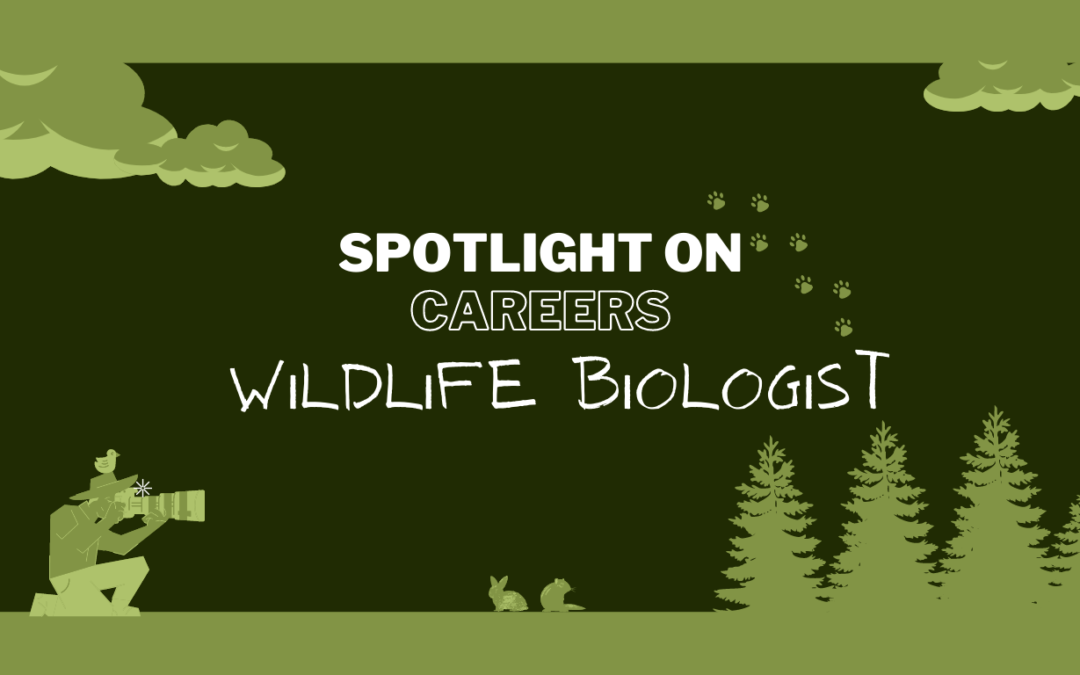Spotlight on Careers: Wildlife Biologist
Written By: Tahreem N
Edited By: Tianna Mair
Designed By: Sophia
Published By: Linda Qi
What is A Wildlife Biologist?
Imagine crouching behind a bush, doing your best not to disturb the herd of elk 150 meters in front of you. You watch the gathering with your binoculars from your hiding spot, taking detailed notes. You are a wildlife biologist, and you have been studying elk groups in the area for the past few weeks to assess the health of the local community. This information will be used by your department to decide how many elk hunting tags can be awarded this year. Every year, thousands of sportsmen seek elk hunting licenses, but the remaining herds cannot support so many losses.
As a wildlife biologist, you are aware of the dangers that overhunting may pose to wild game populations, and you understand how important this survey is to the appropriate management of local elk herds. You count their numbers to determine the size of the herd you’re watching today. However, this does not inform you how many hunting tags will be granted this year. To begin, count the number of men and females; the herd will require a particular number of each to breed. You also consider the elk’s relative age, namely how many mature animals, how many adolescents, and how many of last year’s young have survived. There must be enough young elk to replace those that perish.
After acquiring as much information as possible about the area’s elk herds, you will compare it to statistics from past years to determine population increase or decline. If the population is increasing, you can use the data to estimate how much hunting should be permitted.
Now we may know what type of job a wildlife biologist might do, but how do you become one?
Becoming a Wildlife Biologist:
If you are a high school student interested in becoming a wildlife biologist, you should have good grades or an interest in:
Biology
Mathematics
English
Chemistry
Calculus
In most circumstances, a university undergraduate degree is required for employment as a wildlife biologist. A graduate degree is normally required if you want to do research. If you are a post-secondary student interested in a career as a wildlife biologist, the following programs are most relevant:
Biology of Wildlife
Conservation Biology
Zoology\Ecology
Wildlife and Fishing
Habitat Restoration in Environmental Science
Although certification is not required to practice as a wildlife biologist, some practitioners prefer to qualify for Professional Biologist status. The requirements for this accreditation differ by province.
Work Environment:
Wildlife biologists work in a variety of environments, including:
In the field:
- Study wildlife populations, location data, behavior, and habitat inventories, usually under extremely harsh conditions and within tight schedules
- Ensuring that wildlife restrictions are followed
- Surveying regions from the birds eye view
- Supervising the technical staff
In the office:
- Analyzing data on the computer, including spatial mapping, statistical analysis, and GIS
- Using maps, aerial photographs, and other tools to design field data collection programs
- Answering information questions
- Communicating over the phone and in meetings with clients, government agencies, coworkers, and subject matter experts
- New technology and studies in animal management are being investigated.
- Data collection and preparation of reports and scientific articles
In the laboratory:
- Processing samples acquired in the field or submitted by the general public
- Maintaining and preparing fieldwork equipment
- Technical staff supervision
What Are The Responsibilities Of A Wildlife Biologist:
Duties vary greatly from job to job, but the following are common job duties that a wildlife biologist might encounter:
- Plan and carry out population surveys
- Conduct research, provide recommendations, and supervise habitat restoration and species reintroduction.
- Manage the populations of endangered species, including conservation, protection, and restoration.
- Examine federal and state wildlife programs.
- Review and conduct research for ecological and environmental impact assessments, as well as give information and expert testimony.
- Provide technical skills in the planning of wildlife surveys.
- Collect and analyze data in order to create wildlife management plans and research studies.
- Keep track of wildlife population status and trends.
- Reduce the negative effects of development on animal habitat and resources.
- Meetings with government authorities, consultants, and engineers are required.
- Resolve disagreements over opposing issues and promote good
Wildlife biologists work to protect and preserve Canada’s wildlife populations. They look at things like disease, nutrition, habitat interactions, and population dynamics. Wildlife biologists investigate the effects of environmental change on species survival and development rates, as well as the interactions between wildlife and their ecosystems. They also forecast how land use decisions will affect wildlife and the ecosystems on which they rely.
________________________
Works Cited

